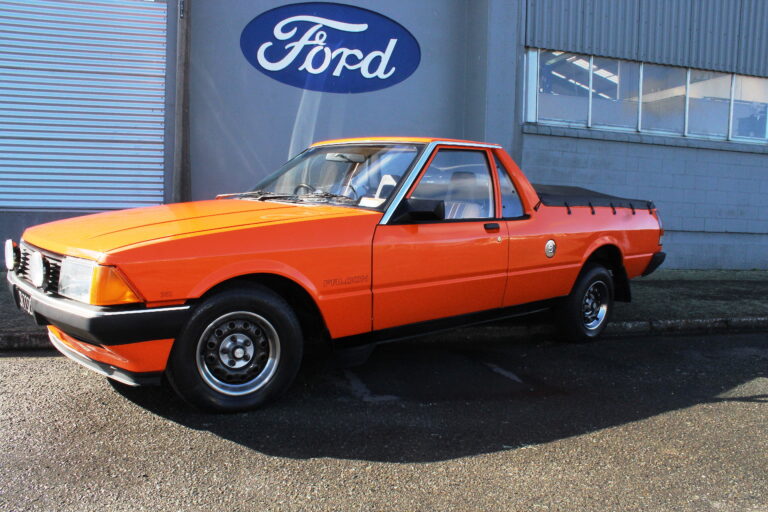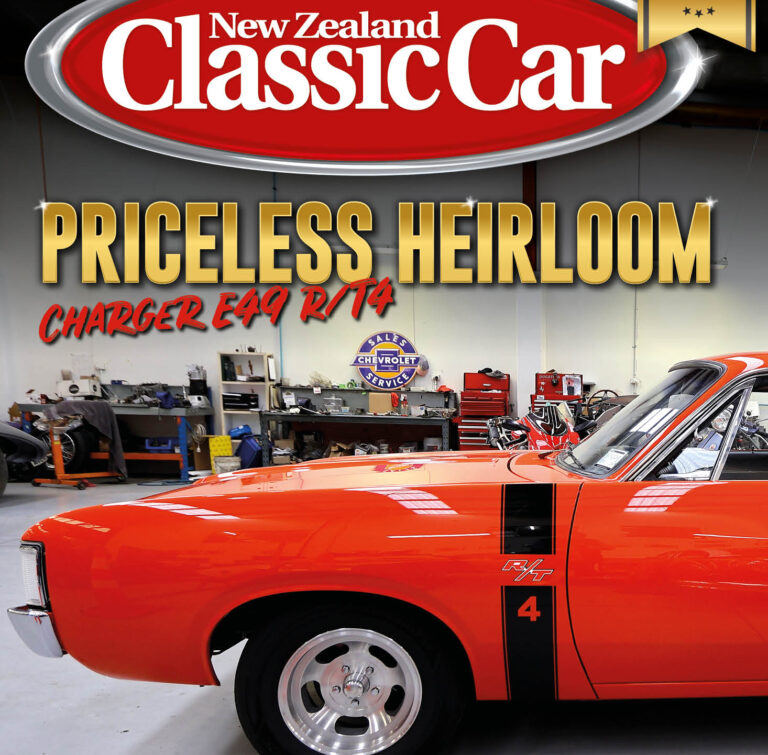“Failure is simply the opportunity to begin again, this time more intelligently.” — Henry Ford
By Quinton Taylor

Ford was on a roll in the mid-1930s, despite the Depression years. His cars were selling well and his new ‘flattie’ V8 was setting the standards for performance, reliability, and smoothness. It was a motor that would give birth to the California hot rod scene and establish hot-up tuning names such as Navarro, Edelbrock, Offenhauser, and Ardun. Bonnie and Clyde even wrote to Henry Ford to tell him how good his Ford V8 engine was …
We get to see many restored classics in the course of featuring cars for New Zealand Classic Car but seldom will one to turn up in such stunningly original condition as this 1941 Ford Super Deluxe Coupe.
Wanaka collectors Jim and Daphne Ledgerwood’s interest in American cars and pickups goes back many years and they have put together an amazing collection, all in top condition.
A founding member of Dunedin’s Hurricane Rodders, Jim has owned many Fords and the occasional Jaguar. These days his focus is on cars with originality and, where possible, with little restoration, preferably none at all.
“As you get older, your taste in vehicles and what you see in them tends to change a little,” Jim explains.
He still has a soft spot for something hot rodded and done well, but the current collection shows those changes with some great cars and pickups. In the meantime, we are focusing on the jewel of the collection. It is simply an amazing car and an absolute time capsule in every sense!

ELWIN’S SUNDAY CAR
Not only is this Ford original condition, but it also has a well-documented history, complete with its Ford, Orange County, dealer invitation to view and its 1941 sales brochure. All documentation is as fresh as the day it was printed thanks to the car’s fastidious first owners, a couple who kept a complete and very precise record of everything done to the car.
Ford introduced a new range of cars in 1941. Production of the ’41 model was wound down through 1942 as the US geared up for war and it would be 1946 before production started again. This is an early 1941 model, as evidenced by the lack of a chrome windscreen surround.
Elwin Soalfelt and his wife purchased the new black Ford in 1941. Ford offered just two trim levels for the coupe, Deluxe and Super Deluxe. They chose the latter. It was their Sunday car, being used only on that day. It was never driven to Elwin’s work or used for any other purpose, and it was absolutely never taken out in the rain. An employee of the Lockheed Aircraft Company in Burbank, California, Elwin had an eye for detail and craftsmanship, evidenced by the neat under-dash panel he fitted to the Ford with switches for the fog, map, backup lights, and accessories. Motorola was the electronics industry leader of the day, so fittingly the Ford was fitted with its Golden Voice radio in place of the Ford factory option, as Elwin preferred its tone. The car was also fitted with other options such as a bumper-bar splash guard, boot light, spare-wheel lock, and exhaust extension.
Each summer, the Soalfelts travelled in ‘Black Beauty’ to Elwin’s parents’ farm in Geyser, Montana — a distance of 1251 miles (2013km) that took nearly 20 hours of travelling time. Elwin would leave his precious car stored in a nearby town, refusing to drive it on the gravel roads surrounding his parents’ farm, and someone would come out from the farm to pick them up.
Following the death of his parents, Elwin inherited the farm in 1958 and he and his wife made the move to Montana to take over the property. Once again, their precious Ford was loaded up, fitted with a set of new tyres. It was then transported out from Geyser by truck, and stored in the barn under a temporary tent made from old bed sheets. The car would occasionally be driven around the farm roads to keep everything running but in the next 20 years it would accumulate only some 200 miles. By 1981, Black Beauty had covered the grand total of 50,027 miles according to Elwin’s detailed log, which even contains the date of every time the car was washed and polished.

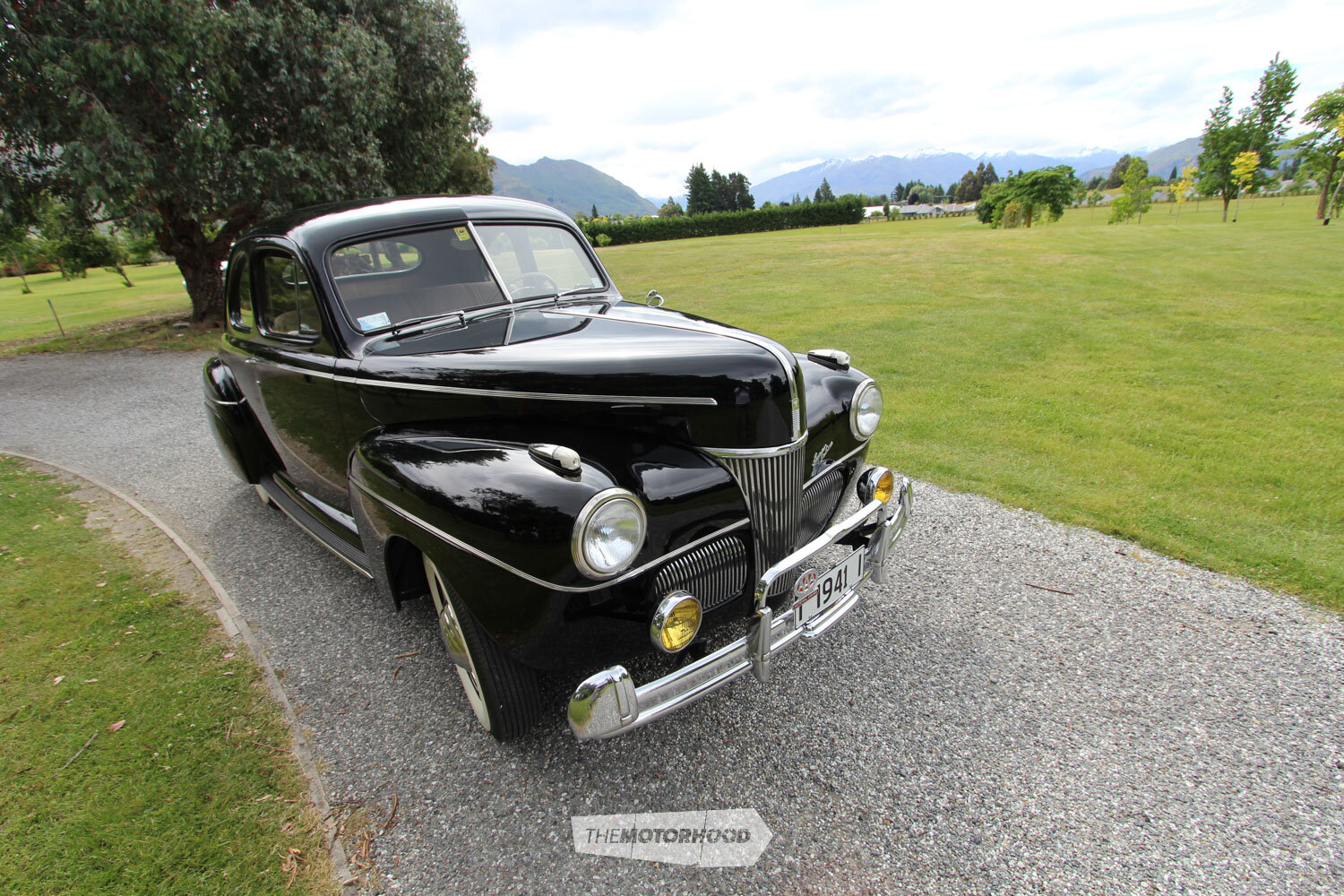
CHASING BLACK BEAUTY
Marshall Lewis of Modesto, California, would become the car’s next owner. His son-in-law’s father knew the Soalfelts. A past-president of the Model A Ford Club of America, he owned a collection of Fords and asked that he be given a chance to buy the car if it was ever offered for sale. When Elwin died, Marshall contacted his widow and expressed his interest. Six months later she made contact and offered the Ford at a strictly ‘take it or leave it’ price. Mrs Soalfelt phoned Marshall back a couple of days later to apologize as she had discovered a small chip in the windscreen and asked if he still wanted the car!
Undeterred, Marshall drove to Montana in 1981 and brought the car back to California on a trailer. Back home, he replaced the 20-year-old tyres with new whitewalls, overhauled the brake master cylinder and wheel brake cylinders, and replaced various hoses and the fan belt. The brakes still had their original brake linings. The engine was checked and serviced and, after relatively little work, the Ford was ready for the road. The car was still in the same pristine condition as it was in 1941. Importantly, Marshall still pampered and garaged the car, preserving what Elwin had started.
TROPHY TIME
In 1983, Marshall and his wife drove the car from Modesto, California, to Dearborn, Michigan, the home of Ford — some 3800km — to take part in the Early Ford V8 Club of America national rally, where it received the Dearborn Award for the best original and unrestored Ford. It was the first of three trips to Dearborn and the nationals, and each time it received a first place ‘walk-around’ award for a perfect score and the most original pre-1950 Ford coupe in the US.

TIME TO SELL
In 1993, the car’s third owner continued the tradition, storing the car in a climate-controlled garage for a further 20 years alongside vintage aircraft, during which time it accumulated a mere 838 miles.
In 2013, Black Beauty was again for sale. Jim and Daphne frequently attended early Ford events in the US. When an agent advised them the car was for sale, they instantly took the plunge and instigated the process to buy it.
“We’ve been going to these Early Ford events for over 40 years so we knew the car,” Jim says.
A substantial sum changed hands and the car duly arrived in New Zealand, joining their great collection of Fords. It is driven only occasionally, on fine days, and sometimes gets to show off its uniqueness at the Wanaka Warbirds & Wheels Museum.
“It’s an amazing-condition car. I don’t think you will see another Ford of this age in as original condition as this one,” Jim beams.
On the day we take up Jim’s offer to come and look the car over, it joins several other Fords. A press on the old-style starter button produces that typical ‘flattie’ Ford whirr and the nearly 80-year-old V8 fires up instantly. You do have to listen hard to hear that it is actually running and there is almost no vibration!
When Henry Ford ordered his team of designers to come up with a new V8 back in the 1930s, his team of engineers were unanimous in their assertion that casting a V8 engine block in one piece was impossible. Nobody else had been able to do it successfully without vibration and reliability problems.

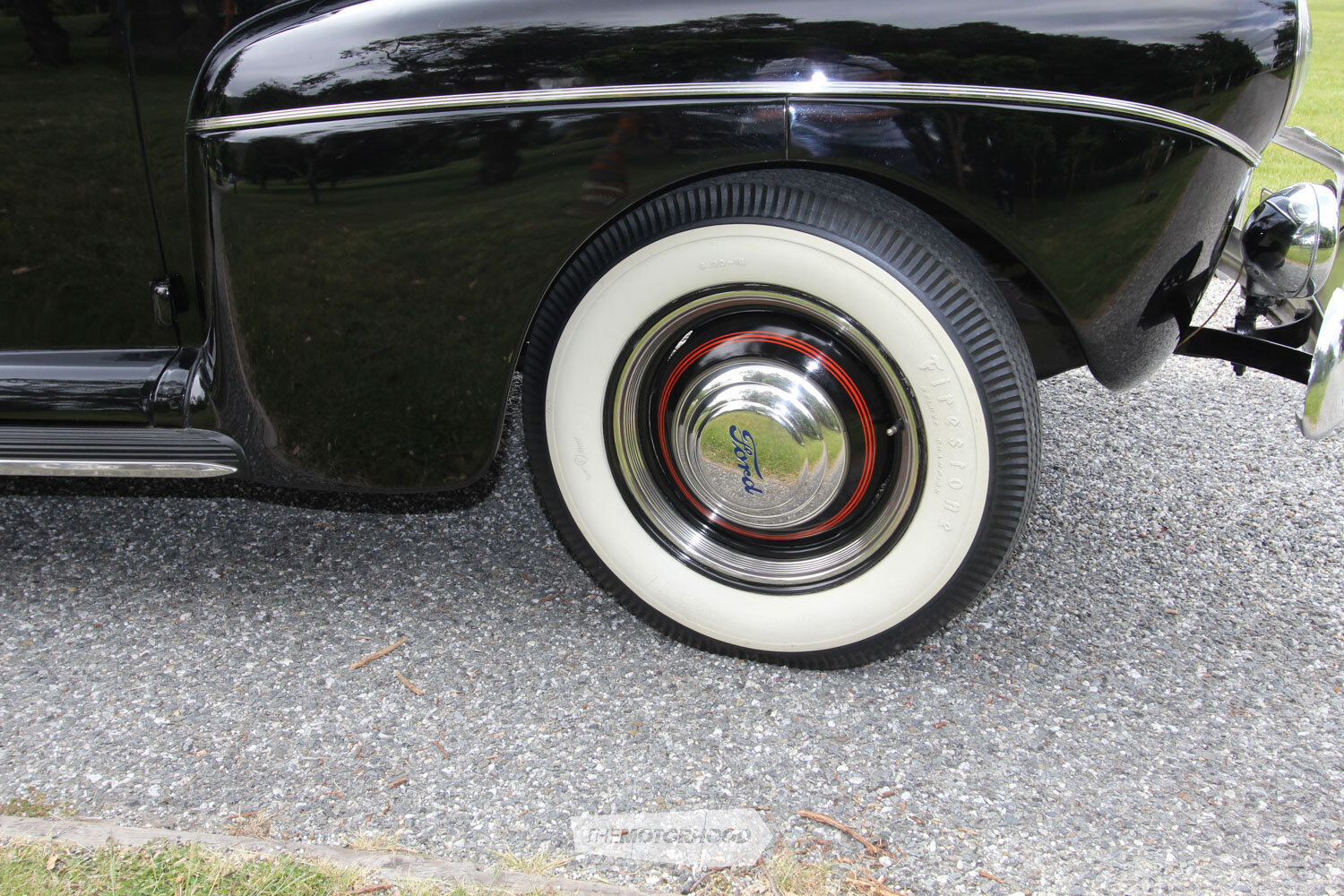
ORIGINAL CHALK
Henry’s reply: “Produce it anyway!”
Out in the warm Wanaka afternoon sun, the original black gloss paintwork still sparkles and shimmers on the businessman coupe–style body. This car has never been scratched or touched up and it has a marvellous patina wherever you look. The door rubbers are original, with a little wear, and the seat upholstery is unmarked and in remarkable condition.
Jim proudly shows off the car’s finer features, including all its accompanying documentation plus a full complement of tools in the rear boot-floor lockers. Flipping open the fuel flap in the left rear mudguard backs up the claim that the paint is untouched.
“It’s still got its original jack and starting handle, and take a look at this behind the seat,” he explains, pulling it forward and exposing sets of original chalk assembly marks as good as if they had been put there by Ford factory workers yesterday.
The cloth interior survived with covers over the seats from new, preserving the bench seat’s soft-tone grey cloth in remarkable condition. Mrs Soalfelt even made custom door covers to protect the painted surfaces when the windows were rolled down.
Jim and Daphne are thrilled to be the guardians of such a well-preserved early Ford — and, make no mistake, it’s quite a coup to have a car so well known on the US car club circuit end up so far south in New Zealand. They are determined to keep it in the condition that others have, especially now it has gone outside the homeland where it resided for many years. Affectionately labelled ‘Claire’, it takes pride of place in their collection. The only gravel it has touched in all those years has been on their driveway, and it still has only a little over 65,000 miles recorded on the speedometer.
“I was so lucky to find this car. We are fortunate to have such a car here in New Zealand and to be able to see how it was done in the US back in the day,” Jim tells us.
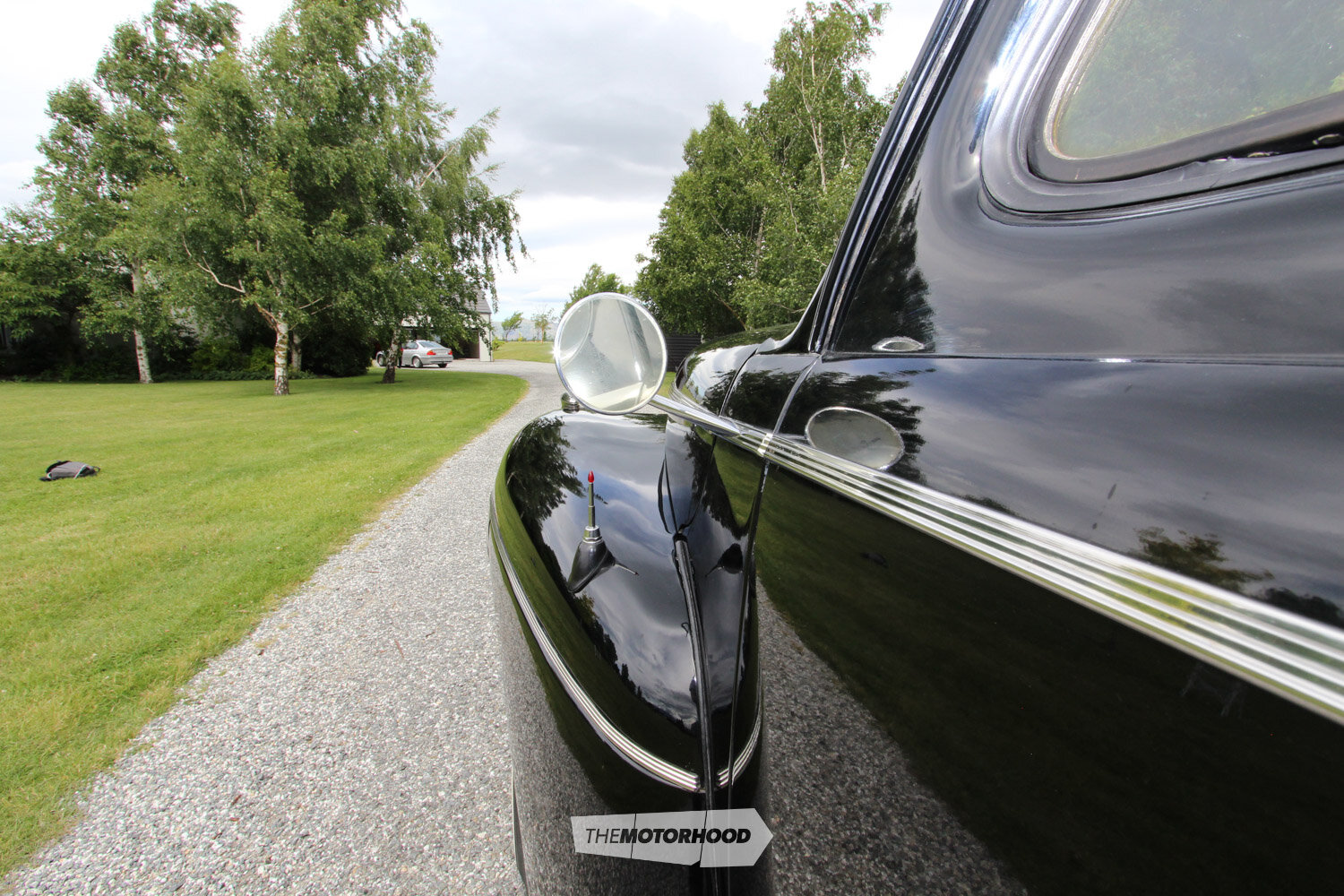

This article originally appeared in New Zealand Classic Car issue No. 361

